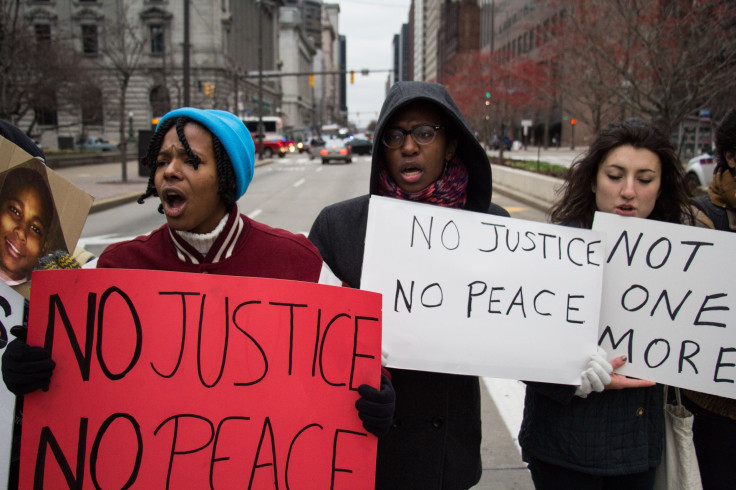Was Tamir Rice Stereotyped? Focus On Cleveland Boy's Physical Build Rooted In US Slavery, Black Parents Say

As a parent of three young African-American children in Philadelphia, Timothy Welbeck said it’s troubling to believe that his children are growing up at a time where their physical build can be used to justify a split-second police use of force, which could prove fatal. That’s the message he and likely many other black parents took away Monday after officials in Ohio announced a grand jury's decision not to criminally charge two police officers involved in the 2014 shooting death of Tamir Rice, a 12-year-old boy carrying a toy gun in Cleveland.
A belief that tall, wide-framed black males pose a physical threat or are inherently violent has survived centuries of so-called racial progress, only to seemingly become a perennial reason to justify lethal force by law enforcement against African-Americans. As a growing number of white officers get cleared of wrongdoing in a cases of police using lethal force against African-Americans, Welbeck and some other black parents noted the explanations offered by Cleveland officials for police conduct that killed Rice find their roots in black male stereotypes formed during slavery in the U.S., perpetuating irrational fears among non-blacks.
“I’m going to have the same conversations about race with my children that my mother had with me,” said Welbeck, an African-American studies professor at Temple University in Philadelphia, who is in his early 30s. “My mother knew that I lived in a different reality than my white counterparts. You can’t exercise the same freedoms in the same way because the consequences can be fatal.”
The words of an assistant prosecutor who handled the Rice case – one of the most high-profile and controversial U.S. cases of black death by police over the last year – were most searing for Welbeck. Only Tamir's friends knew he was 12 — he had a 5-foot-7 and 175 pound frame, size-36 pants and extra-large men's jacket — but the officers believed he was in his 20s, Matthew Meyer, an assistant prosecutor in the Cuyahoga County (Ohio) prosecutor’s office, said Monday in a news conference about the case
A grand jury decided Monday against indicting Timothy Loehmann and Frank Garmback, the Cleveland police officers involved in the Rice shooting that took place Nov. 22, 2014. Although video surveillance taken of the city park where the boy was shot and 911 dispatcher recordings raised questions of whether their actions were reasonable, Loehmann -- a white rookie Cleveland officer who was previously deemed unfit for duty as a police officer elsewhere in Ohio -- fired at Rice, and Garmback -- who drove a police cruiser toward the boy just seconds before the shooting -- were cleared of any wrongdoing on the grounds that they feared for their lives.
The stereotypes of black males that may have inspired their fear, even subconsciously, were borne out of the institution of slavery which commodified blacks and later sought to villainize them as free people, scholars have said. Perhaps the most famous example of how those stereotypes were perpetuated came with the 1915 release of “Birth of a Nation,” a post-Civil War film that suggested newly freed brute-like and morally deviant black men would rape and pillage the U.S. without white supremacist rule. That also meant heinous crimes against blacks under a legal system built to support fear-based stereotypes, said Eddie Glaude, Jr., a professor of religion and African American studies at Princeton University in New Jersey.
“The stereotypes stand in for the actual lived-lives of human beings,” Glaude, who is black and a father to a 19-year-old son in college, said in a phone interview Tuesday. “If the stereotype is always rooted in fear, then you’ll always have legal recourse to claim that you feared for your life,” he added, referring to police statements in the Rice case.
Changing the racial biases that create these stereotypes starts when society acknowledges that it systemically denies black men, women and children the same civil rights, human dignity and childhoods afforded to their white counterparts through the use of these stereotypes, Glaude added. “If we are going to change those habits [of using racial stereotypes] we have to change the society, how we think and how we function. Our children must be seen as children,” he said.
For some black parents, the only defense against long-existing racial stereotypes is a frank conversation with their adolescent sons and daughters. Augustus Corbett’s 21-year-old son is 6-feet-3-inches tall and is “a man at this point in his life,” he said in a phone interview Tuesday. “Sometimes the slightest violations of code and customs, let alone the law, can result in the death of black males – and for that reason I have spent a great deal of my time warning my son about it,” said Corbett, an attorney in Texas who is also chairman of the National Black Parents Association, an advocacy group based in Dallas.
He added: “We must do everything that we have to do to keep our kids out of harm’s way.”
© Copyright IBTimes 2024. All rights reserved.






















